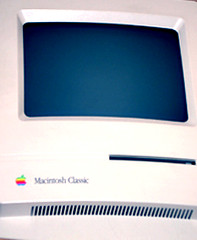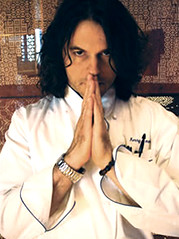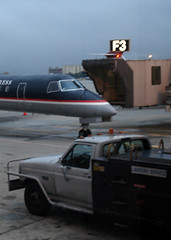“I don’t see the connection … it can’t be done … we don’t have time … we’ve tried that before … I can’t be bothered by those things … there is no value.”
And so goes the growing list of comments that some social media practitioners say they hear when they talk about social media. Are you surprised? I’m not. These communication killers have been around a long time. I don't expect they will be going away anytime soon either.
We’ve heard them often enough over the last 16 years, starting the day I founded our company with nothing more than a monochrome Mac Classic (yep, the one in the picture) and a fold-out card table set up in the kitchen of a one-bedroom apartment. It won’t work. It can’t be done. Nobody will take you seriously.
Sure, it wasn’t always easy. I’ve had some hits and misses along the way. But nonetheless, despite any naysayers, our company turned sweet 16 yesterday and I took time out to answer Eight Random Facts About Me after being tagged.
One random fact I didn’t share is that I have faith in underdog ideas: anything from social media as a viable tool to meet strategic objectives to the convergence of broadcast and the Internet. Everything from engaging consumers (like Jericho fans and Veronica Mars movie advocates) to encouraged consumer marketing.
Why? Because I believe well-grounded ideas that are backed by ample passion and persistence will work, provided they have the right message. In fact, in working with countless startups, the only good ideas that seem to fail are those where the "idea people" never perfect the message beyond the choir and/or give up before they do.
Social media is a great example. For the most part, practitioners have not proven its potential beyond themselves, possibly because they are too close to the source. This error was made apparent to me once again on Linkedin.
I asked “What is the one social media question that you feel has not been adequately answered by communication experts in this area?” Josh Weinberger, an independent writing and editing professional in New York City, was first out of the box.
”I'd like to see more coverage of how social media is enabling ‘regular’ businesses to conduct their traditional activities.”
His response strikes at the very core of where today’s social media advocates are going wrong. Web traffic? Page rank? Power lists? Social connections? SEO? Comment counts? Global exposure?
None of these hot topics resonate with 'average' businesses. So what we are seeing is that all too often, social media practitioners are providing second-tier and third-tier answers to a first-tier questions.
What can social media do for my business? It depends on the business. And here are a few examples:
• A professional practice (attorneys, accountants, medical practitioners, image consultants, etc.) can employ social media to expand and reinforce their expertise in the field. Blogs, in particular, move the conversations away from talking about ourselves and toward taking about what matters to our potential clients.
• A retail outlet can employ social media to communicate product reviews, shopping tips, and promotional events. If I were calling the shots for Wal-Mart, I would have already budgeted for an online home decorating show, which could help sell products as well as improve the company’s public image.
• An organization consisting of members can employ social media to reinforce online networking, promote upcoming events, and cover topics that are relevant to their membership without spamming their e-mail.
• A large corporation, such as a utility, can employ social media on an Intranet, encouraging departments to learn from each other and develop a consistent internal message prior to presenting rate cases.
• A recruiter could position themselves as an employment expert by not just talking about the industry, but by also developing a online publication that aims at providing tangible career advice to any industry in which they wish to specialize.
Social media may have changed the communication landscape, but it did not change the strategy behind it.
What is the situation? What is the objective? How will we achieve it? Who is the audience? What is the measurement for success? Unless we answer these questions, making sure social media programs are grounded in strategic communication, then all we are producing is entertainment.
Why is Copywrite, Ink. celebrating its sweet 16? Talk less. Ask more. Because if I have learned anything it is that when you ask the right questions, you can gain deeper insight and provide much more meaningful information.

And so goes the growing list of comments that some social media practitioners say they hear when they talk about social media. Are you surprised? I’m not. These communication killers have been around a long time. I don't expect they will be going away anytime soon either.
We’ve heard them often enough over the last 16 years, starting the day I founded our company with nothing more than a monochrome Mac Classic (yep, the one in the picture) and a fold-out card table set up in the kitchen of a one-bedroom apartment. It won’t work. It can’t be done. Nobody will take you seriously.
Sure, it wasn’t always easy. I’ve had some hits and misses along the way. But nonetheless, despite any naysayers, our company turned sweet 16 yesterday and I took time out to answer Eight Random Facts About Me after being tagged.
One random fact I didn’t share is that I have faith in underdog ideas: anything from social media as a viable tool to meet strategic objectives to the convergence of broadcast and the Internet. Everything from engaging consumers (like Jericho fans and Veronica Mars movie advocates) to encouraged consumer marketing.
Why? Because I believe well-grounded ideas that are backed by ample passion and persistence will work, provided they have the right message. In fact, in working with countless startups, the only good ideas that seem to fail are those where the "idea people" never perfect the message beyond the choir and/or give up before they do.
Social media is a great example. For the most part, practitioners have not proven its potential beyond themselves, possibly because they are too close to the source. This error was made apparent to me once again on Linkedin.
I asked “What is the one social media question that you feel has not been adequately answered by communication experts in this area?” Josh Weinberger, an independent writing and editing professional in New York City, was first out of the box.
”I'd like to see more coverage of how social media is enabling ‘regular’ businesses to conduct their traditional activities.”
His response strikes at the very core of where today’s social media advocates are going wrong. Web traffic? Page rank? Power lists? Social connections? SEO? Comment counts? Global exposure?
None of these hot topics resonate with 'average' businesses. So what we are seeing is that all too often, social media practitioners are providing second-tier and third-tier answers to a first-tier questions.
What can social media do for my business? It depends on the business. And here are a few examples:
• A professional practice (attorneys, accountants, medical practitioners, image consultants, etc.) can employ social media to expand and reinforce their expertise in the field. Blogs, in particular, move the conversations away from talking about ourselves and toward taking about what matters to our potential clients.
• A retail outlet can employ social media to communicate product reviews, shopping tips, and promotional events. If I were calling the shots for Wal-Mart, I would have already budgeted for an online home decorating show, which could help sell products as well as improve the company’s public image.
• An organization consisting of members can employ social media to reinforce online networking, promote upcoming events, and cover topics that are relevant to their membership without spamming their e-mail.
• A large corporation, such as a utility, can employ social media on an Intranet, encouraging departments to learn from each other and develop a consistent internal message prior to presenting rate cases.
• A recruiter could position themselves as an employment expert by not just talking about the industry, but by also developing a online publication that aims at providing tangible career advice to any industry in which they wish to specialize.
Social media may have changed the communication landscape, but it did not change the strategy behind it.
What is the situation? What is the objective? How will we achieve it? Who is the audience? What is the measurement for success? Unless we answer these questions, making sure social media programs are grounded in strategic communication, then all we are producing is entertainment.
Why is Copywrite, Ink. celebrating its sweet 16? Talk less. Ask more. Because if I have learned anything it is that when you ask the right questions, you can gain deeper insight and provide much more meaningful information.



















